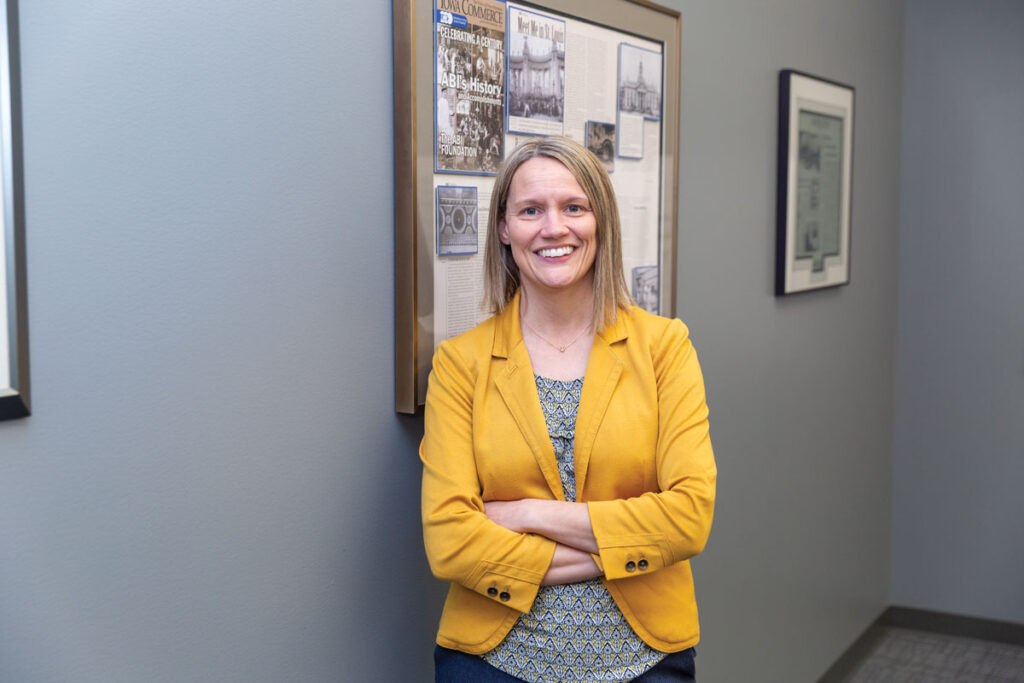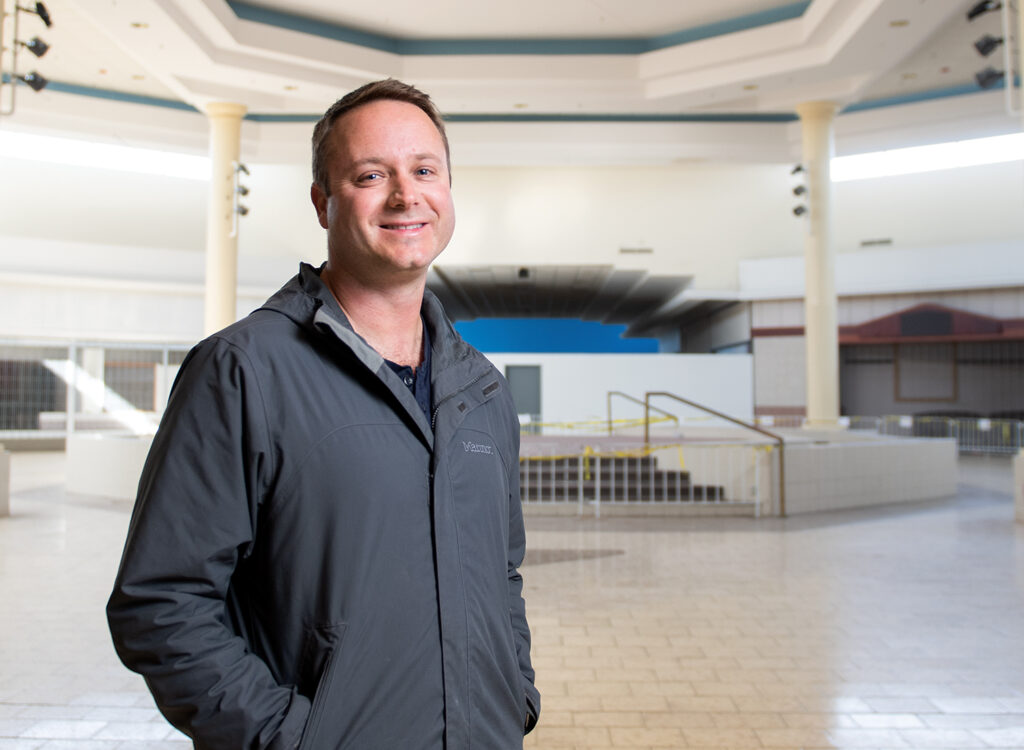A Closer Look: Mike O’Donnell
Director, Center for Industrial Research and Service at Iowa State University

Business Record Staff Sep 29, 2023 | 6:00 am
12 min read time
2,921 wordsA Closer Look, ManufacturingMike O’Donnell’s interest in math and physics drew him to study mechanical engineering, but the hands-on work of resolving problems on the factory floor demonstrated unique problem-solving opportunities that lie in manufacturing.
“In manufacturing, you get all of the challenges of how do you make something with all of the challenges of how do you get large groups of people to work together?” O’Donnell said.
Making the leap from a role in Sydney, Australia, to Iowa 15 years ago to work for the Center for Industrial Research and Service at Iowa State University started a journey into Iowa’s manufacturing scene that continues today as O’Donnell now leads the organization as director.
He started his new role in June after coming up through the organization from serving as a project manager to spending 10 years leading CIRAS’ Manufacturing Extension Partnership, which oversees the center’s manufacturing services.
CIRAS focuses on filling in gaps that aren’t already met by private industry or other statewide partners for small to midsize clients. About 60% of CIRAS’ clients are from the manufacturing industry, O’Donnell said, and the remainder come from the construction and professional services fields.
We recently caught up with O’Donnell about current trends in manufacturing and his new role.
This Q&A has been lightly edited and condensed for clarity and brevity.
What are some of the biggest changes you have seen, or gaps CIRAS has helped close, in your 15 years here?
If you look over time, and even going further before I started here, it was originally back in the late 90s and early 2000s, the focus was on the fundamentals of quality. You hear ISO 9000, those types of tools, and then as that started to become more and more well applied across the state, lean manufacturing became a big thing. For a long time, we were the place for quality, and then as the private industry started to come up, we faded away from quality. We were one of the key sources of lean in the state, we partnered with community colleges to make sure that the training was out there, the resources were out there. Lean really split apart about 10 years ago, into the companies that were thriving with it and the companies who weren’t getting it.
What is Lean Manufacturing?
Lean manufacturing is a methodology that focuses on minimizing waste within manufacturing systems while simultaneously maximizing productivity, according to TechTarget. Waste is seen as anything that customers do not believe adds value and are not willing to pay for. Some of the benefits of lean manufacturing can include reduced lead times, reduced operating costs and improved product quality. The five principles of lean manufacturing are identifying value, mapping the value stream, creating flow, establishing a pull system and striving for continuous improvement.
The Iowa Lean Consortium was one of our programs. It was a standalone nonprofit that merged into CIRAS about five years ago, where we pool resources to bring in world-class lean trainers into Iowa. Companies are continuing to move into lean, but the companies who really love lean, they partner together and they use this consortium as their way to be excellent in it. But a lot of Iowa industry kind of faded away from lean, so the challenges then became how do we become more productive if lean isn’t what’s going to work for my company? That’s what drove into more of the technical stuff that we do today. How do you automate now? I would say, and our whole team says till we’re blue in the face, step one, is to develop great people. Step two is to have those people make great processes, and then step three is to use technology to automate the parts of the processes that don’t need those great people anymore. In reality, we think it’s all connected and for a lot of companies it is, but that’s the big push, given our workforce constraints, given the changes in technology and the fact that it’s gotten much cheaper and more capable at the same time, how can we automate?
What is the current state of play for manufacturing technology?
When you back up and you talk about manufacturing, they talk about industrial revolutions. We’re in this transition between the third and the fourth industrial revolution. The third is what you think of when you think of automation historically. It’s big robots. It’s high-speed manufacturing lines that have really rigid products, so you put out a lot of one product very quickly, with automated sensors and those types of things. It’s high volume, very low mix, very capital intensive, massive automated factories. That’s the third industrial revolution. You’re going to see that in Iowa in the food industry, very significantly in the food industry. You’re going to see that in some of the machinery manufacturers that you see around the state. And anywhere that you’re going to see some moderately high volume of manufacturing, you’re going to see some level of automation. If you have a company that makes a lot of plastic products, and you make a lot of a handful of parts, then you’re going to see robotic loading and unloading of those cells. That’s the baseline that I would say about half of companies are starting with.
This fourth industrial revolution, the next, the now, the things that we’re seeing today is this really cool convergence of a lot of different technologies. It is things like collaborative robots, which a lot of people have started to see. These are cheaper robots that tend to be a quarter of the price of a traditional robot that moves slower, is more flexible, is generally safer, and can be typically programmed with visual programming, like drag and drop programming, cheaper sensors, better connectivity, things like the Industrial Internet of Things, cloud computing, artificial intelligence — it’s all those. Where it’s really amazing is it’s all those not just on their own, but it’s coming together to solve specific problems that you couldn’t solve in traditional industry 3.0 manufacturing. The ability to produce, at high speed and high volume, 50 products, as opposed to two products and having computers connected to machines that can see a color and say, “Oh, if it’s this color, then I know I need to do this to the product.” That type of intelligence built into whole systems is that industry 4.0 concept.
What shape does AI take on manufacturing floors right now? What does the technology mean to manufacturers?
I was talking with a group recently about what’s next for manufacturing and what the next few years look like. My initial response was it’s coming up with a real, sustainable solution on workforce, supply chain and technology, and not just on their own, but how they interact with each other. How can the three play off each other to solve each other’s problems? All of that is being done with this cloud of AI hanging over of can we figure out how, when and why we use AI as part of that solution? Is it a risk? Is it an opportunity? The answer is probably yes on both of those, but how does it actually work? Things like the large language models, like ChatGPT, are the new cool thing, but if you peel back a layer, you’re starting to see different machine learning technologies, and data-driven tools being applied more and more in businesses, both on the front end in terms of marketing and product development, and on the production processes too. There’s no way that doesn’t impact manufacturing. It’s just a matter of when and how.
You named workforce, supply chain and technology as focus areas for the manufacturing industry. How are those taking shape in your role as director of CIRAS?
Given that I’ve been doing the manufacturing side for 10 years, I have a fairly good feel on the manufacturing side. What my focus has been for two months is talking with our team about where their challenges and opportunities are, talking with partners across the state, and stakeholders across the state to understand how we can be a better partner so that we can continue to be really great at serving the industry. When I think of the near term, that workforce supply chain and technology is the now issue. Regardless of what industry you’re in, as we look forward, some of the things that we’re talking about are one, how can we serve the technology needs of the construction industry just as well as we do in the manufacturing industry? That is a potential need that we’re trying to understand. It’s entirely possible they have the resources they need, but we need to understand that better because all the changes we’re seeing in manufacturing, we’re seeing similar things in construction. One of the new things in industrial construction is live model scanning, so they don’t do as-built drawings, they do an as-built scan of the product. Do small and midsized construction companies have the resources they need to make the good decisions on that?
The other two places, from a focus standpoint that we’re hearing from stakeholders are one, how do we better connect some of the expertise at the university with the research needs of manufacturers across the state? That’s something that we have started the process of moving down. Second, how do we create even more opportunities for Iowa companies to engage with Iowa State students throughout their college career in more and more different places? One of the things that we’re really proud of is we support connecting companies with capstone projects. One of our big questions is what’s next? What’s the next way we can continue to help facilitate those relationships? I firmly believe that a university that does a great job helping students connect and find the right career throughout their college degree is in a great place. At the same time, companies who can engage with students younger and younger, to show them the great careers they have, especially those right here in Iowa, helps the companies too.
How is the advancement of manufacturing technology going to change the skills that workers in the industry need?
One of the big challenges here is it’s hard to make something — physically making products is incredibly difficult. You’ve got all these manufacturing processes, you have to understand in detail very specific things, whether you’re cutting metal, injecting plastic, blending foods, there’s a technical depth to that. If you’re at any level in manufacturing, you’ve learned a whole lot about how to make something. As we move into the future, that’s not going to be enough, because you’re going to have to know how to make something and how to manage the robots that make that so that when there are problems, you have the capability to troubleshoot that. Managing the robots isn’t simply a robot. It’s networked robots. It’s other sensors. The idea of just making something is only part of the story now. You need to be able to understand how to make something and how to interact with a variety of different technologies regardless of your role in the company, from the shop floor through the C-suite, you need both of those skill sets. One of the things we’ve done is we’ve been partnering with community colleges, ABI, state agencies on what we’re calling the Manufacturing 4.0 Consortium in just starting to build that foundation of what really is needed, from a training perspective, from a workforce perspective, from an economic development perspective? Where are the gaps? How are we going to get there? And we don’t have answers, but we have the right people at the table still, and that gives us confidence that we’ll get there.
How can the manufacturing industry manage the generational shift occurring in its workforce?
Manufacturing is dominated by baby boomers; they came in on the upswing of manufacturing. The average age of manufacturing has continued to increase. There are not enough young people in Iowa, or realistically, anywhere in the country. As the baby boomer generation starts to retire, we don’t have enough people to replace them. That’s where, from my perspective, technology becomes part of it, both from a math standpoint, in other words, rather than having one person loading and unloading the machine, have one person leading six robots that load and unload six machines is part of that. But then how do you show people that the old, dark and dirty jobs of manufacturing are going away, and the jobs are I get to run six robots and troubleshoot them and learn how to code them? All manufacturing jobs suddenly become these really cool jobs. I’ve spent a lot of time in a lot of manufacturing companies and worked with a lot of people. What’s really cool about manufacturing is no matter where you come in, there are career paths. If you want to become the best in the state at running a piece of equipment, there are ways to do that. If you want to work your way to running a factory, there are ways to do that. And it’s not just on the shop floor, it’s in engineering, it’s in human resources, it’s in finance, it’s in marketing. All those cool careers are in manufacturing, and it’s about retelling that story about what manufacturing is today. That’s how you get that next generation in there.
Does internet connectivity remain a challenge for manufacturers in rural areas as technology requires more advanced capabilities?
I would say more often than not, and there are always exceptions, internet speeds in manufacturing companies across the state meet their current needs. Five or 10 years ago, if you were a company that wanted to use an online software, and you were in rural parts of Iowa or even in some of the metro areas, you did not have the internet speed to be able to do that. That is rare now. What I think we’re going to see is another step function, where there’s another step of data, both capacity in terms of bandwidth and speed that is going to hit with some of the next generation of tools, and it’s going to be a race to see what hits first, the internet capacity in the rural areas or the tools.
What are Iowa’s future innovation opportunities in manufacturing and what is CIRAS’ role in those?
In Iowa, when we talk innovation, we tend to talk product innovation and process innovation. On the product innovation side, where Iowa is incredibly strong, is in the food, bioscience and biochemical space. It’s continuing to invest in and support innovation in the product space for that, while finding ways to make that here. Innovation for the sake of innovation is good. Having those innovations is good. But having those innovations and making that product here is where you start to get the huge economic benefit of manufacturing. The other side of it is process innovation, and whether you’re a job shop or you have your own product line, continuing to innovate and find the best way to make your product is that key.
Most of our product innovation tends to be in that bio, and food and ag-related side, the process innovation is across all of industry. It’s making sure that companies continue along those paths, and don’t think that we have the way to make something. Being willing to step back and say, has this changed? That’s things like 3D printing. If you were to look back 20 years ago, 3D printing was a cool tool that you could use to prototype something. Today, 3D printing, if you want it for prototype, you can get a full color prototype that looks exactly like your final product. If you want it for other things, it’s useful there too. We’ve done things like using metal to print injection molds for companies. Probably the most common use for 3D printing that we see today is shop floor tooling and fixtures. Why wait six weeks for a tool to be made? When you have a problem on the shop floor, draw it up, print it overnight, you have it in the next morning. Those types of process innovations are what keep companies ahead, being able to increase that speed of change.
What are your thoughts on CIRAS’ future direction?
Our mission stays the same. We’ve been around for 60 years. We help industry with their biggest challenges. One of the things we did this spring was with our 60th anniversary coming up, we went into the university archives, and found some of the initial documents that justified what a CIRAS was and what companies needed, and it’s amazing to look at it because when you see what they said, it’s still what we are today. It’s exactly — almost word for word — the challenges and the reason for us haven’t changed. The world is changing faster than one company on their own in Iowa can understand and make effective decisions on. Our job is to be that second independent, unbiased adviser for them, help them understand what’s changing. The technologies and the changes 60 years ago compared with today are different, but the model is still the same and it will always be the same.
At a Glance
Hometown: South Hadley, Mass.
Education: Bachelor’s and master’s degrees in mechanical engineering, Bucknell University; Master of Business Administration, Iowa State University.
Contact: modonnell@iastate.edu










